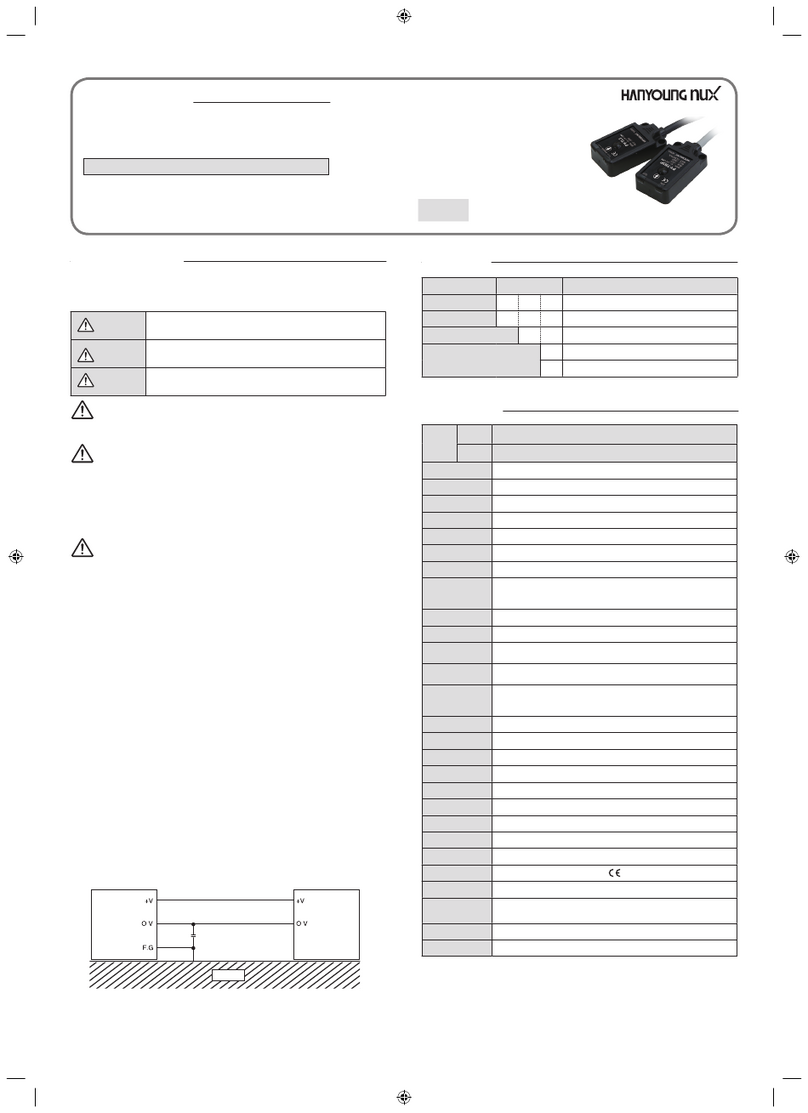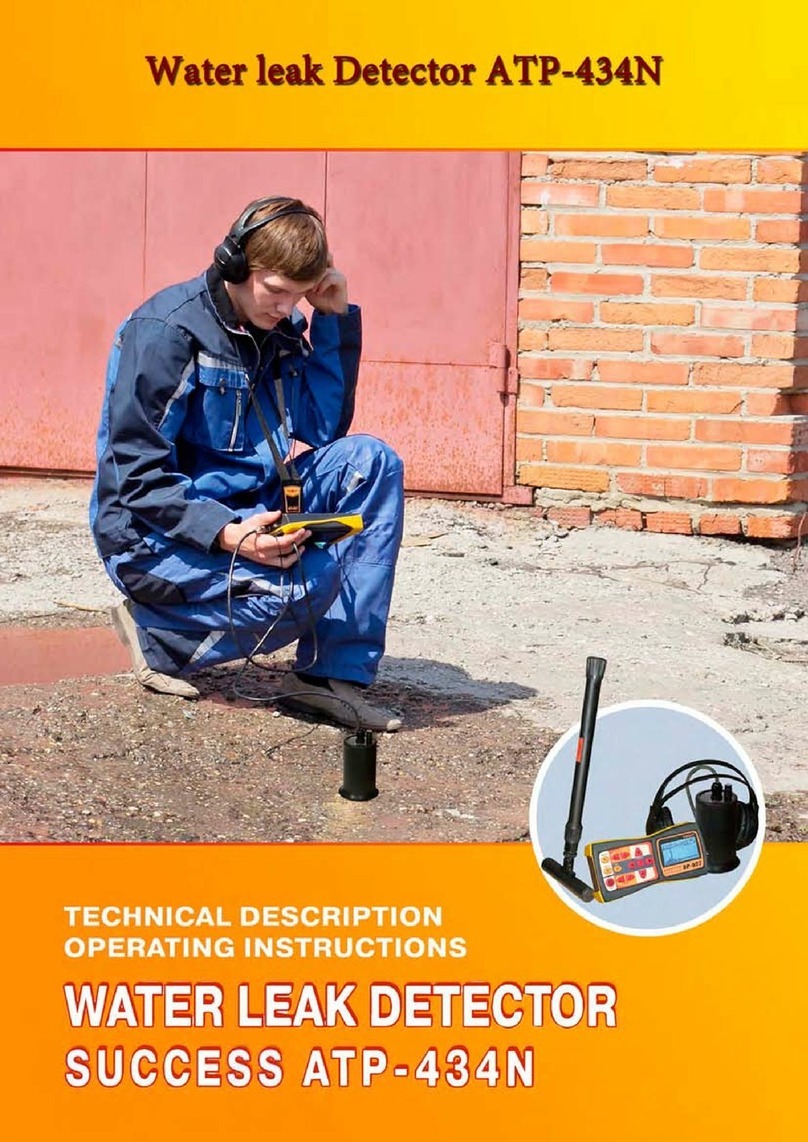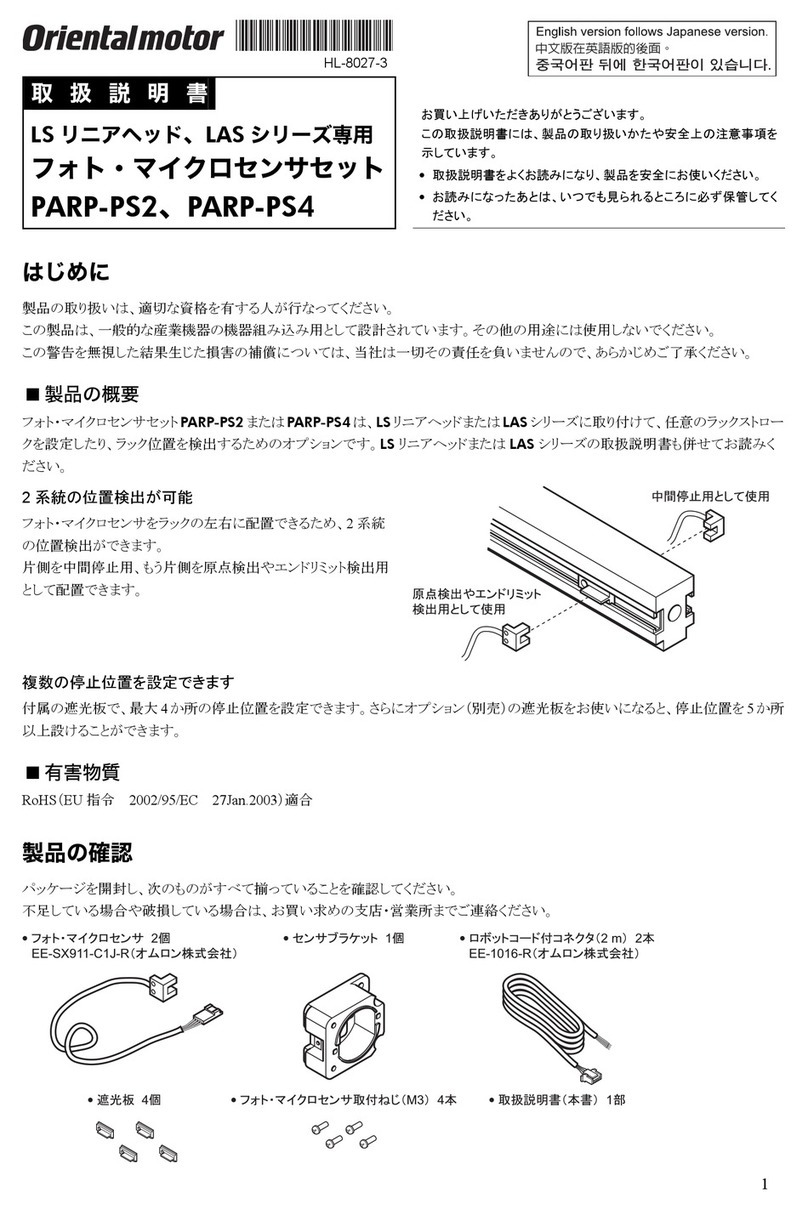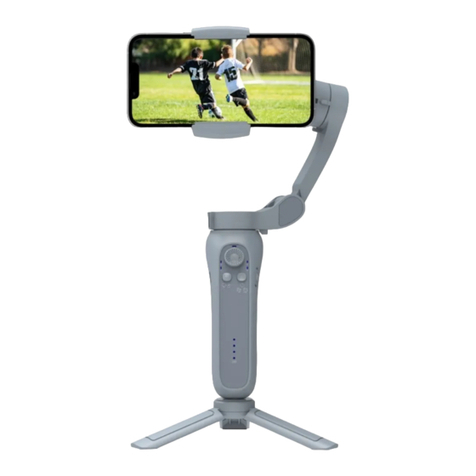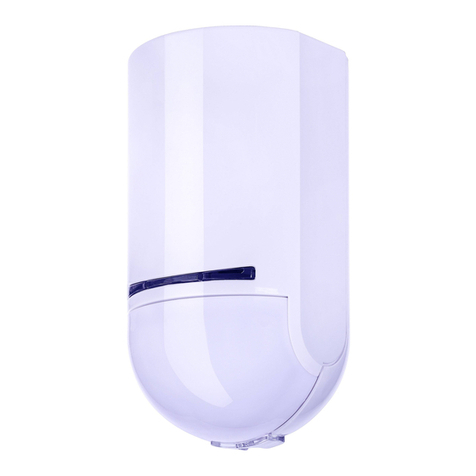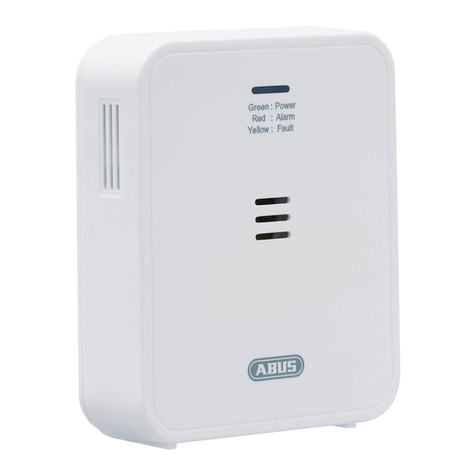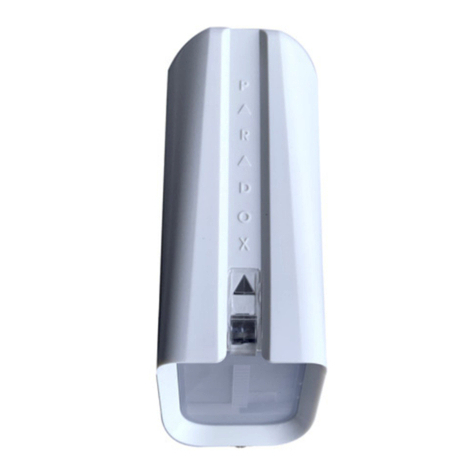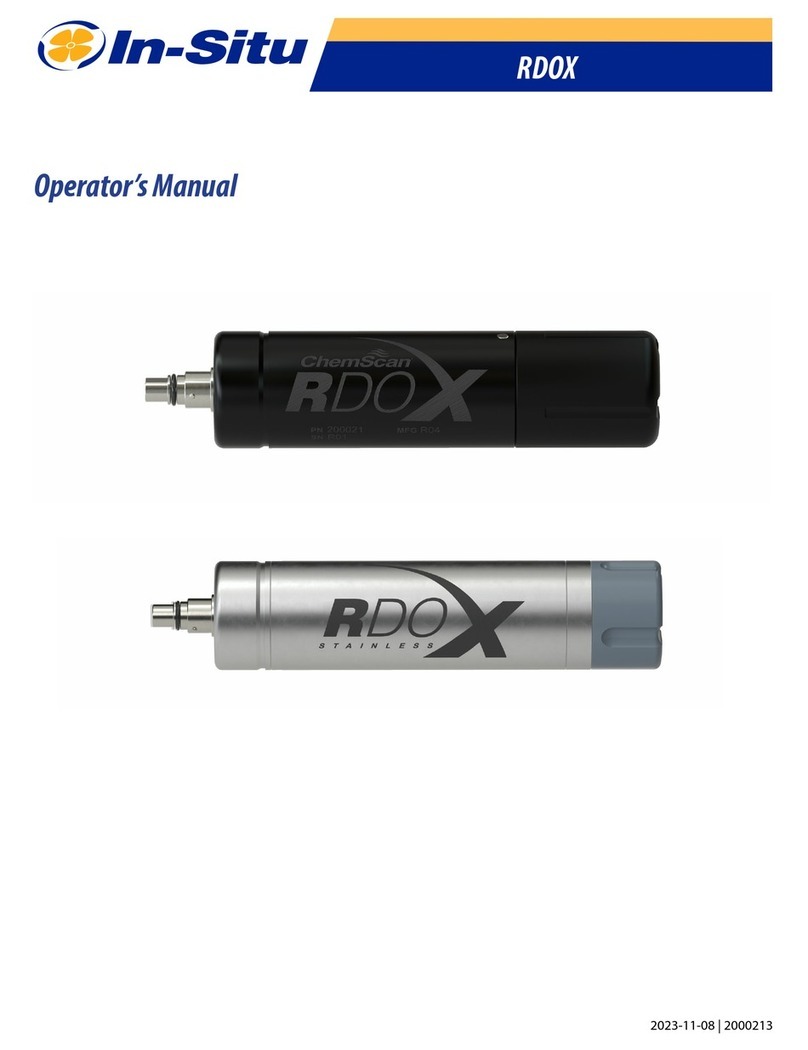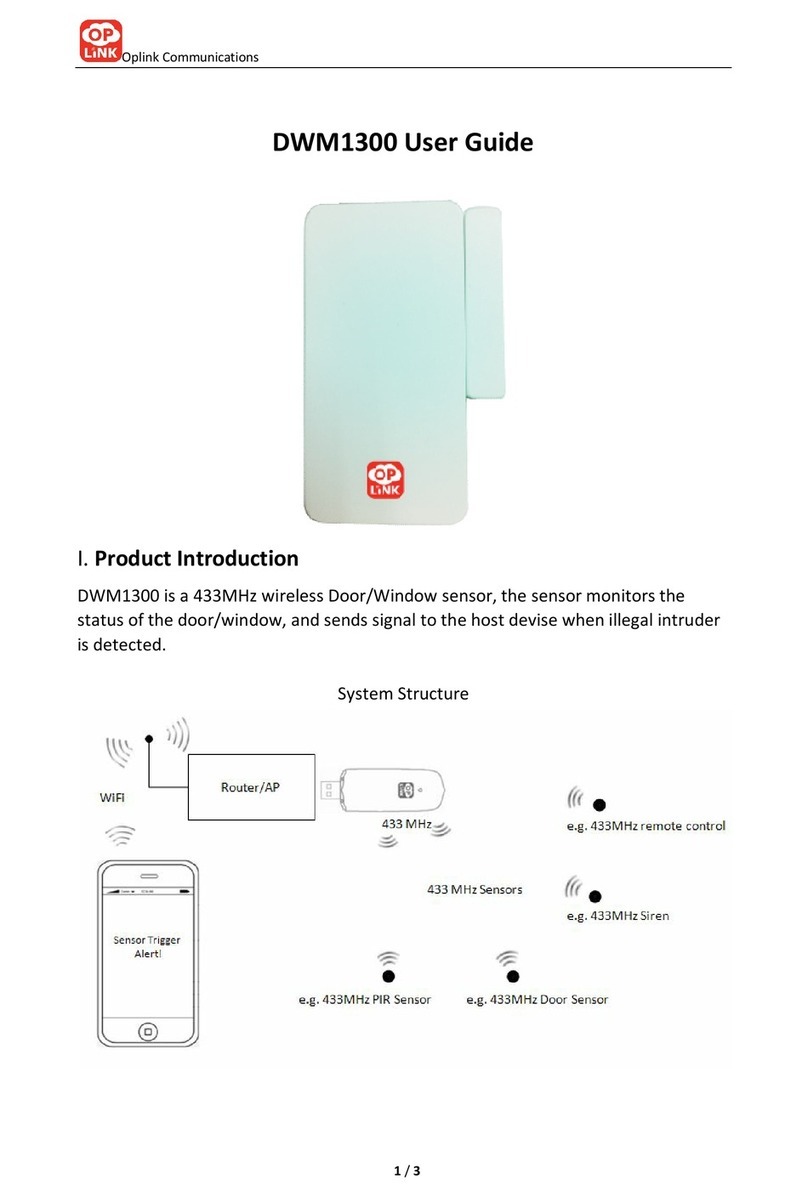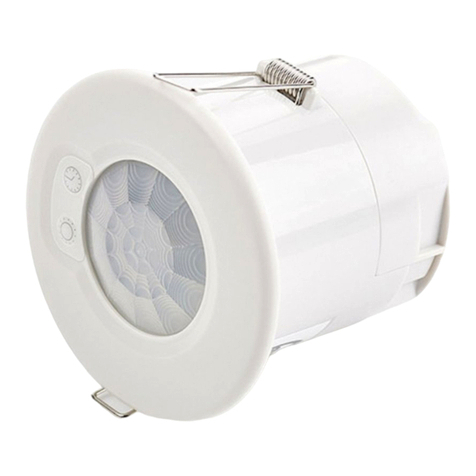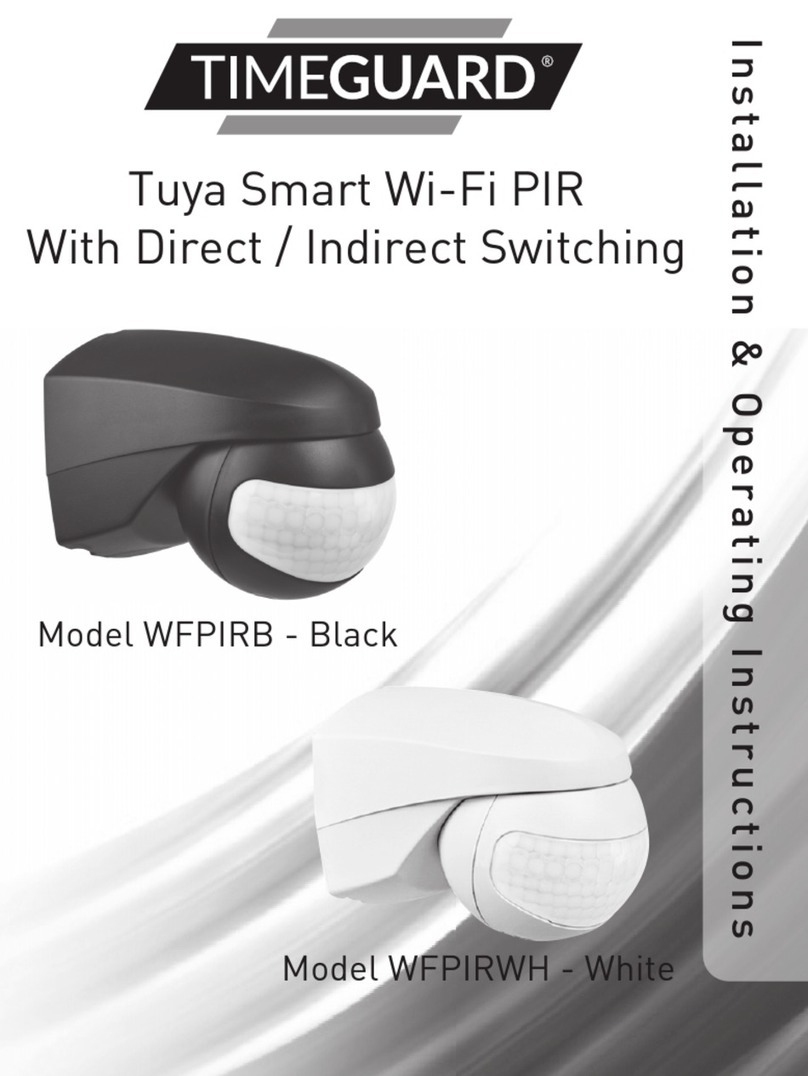CREE LIGHTING FSP-2X1 User manual

FSP-2X1
Digital High/Low Pir Fixture Integrated Sensor
1 of 7 CI369X01R4_A
INSTALLATION INSTRUCTIONS
INSTRUCTIONS D’INSTALLATION
SENSOR DESCRIPTION
The FSP-2X1 is a motion sensor that controls lighting
levels based on occupancy and ambient light. This slim,
low-profile sensor is designed for installation inside
the bottom of a light fixture body. The PIR lens module
connects to the FSP-2X1 through a 1.30" diameter hole in
the bottom of the fixture.
The sensors uses passive infrared (PIR) sensing
technology that reacts to changes in infrared energy
(moving body heat) within the coverage area. Once
the sensor stops detecting movement and the time
delay elapses, lights will go from high to low mode and
eventually turn off if it is desired. Sensors must directly
“see” motion of a person or moving object to detect them,
so careful consideration must be given to sensor luminaire
placement and lens selection. Avoid placing the sensor
where obstructions may block the sensor’s line of sight.
See Figure 1.
The FSP-2X1 operates at 120V/230V/240V/277V/347V/480V,
no power pack is required. It is designed to be installed
in indoor and outdoor environments. Once the device is
initially powered up, the FSP-2X1 will use factory default
parameters to operate. If adjustments are needed, the
programming tool must be used.
Light Sensor
IR Transmitter
IR Receiver
PIR Sensor
Motion
Indicator
Red LED
1
IMPORTANT SAFEGUARDS
When using electrical equipment, basic safety precautions should always be followed including the following:
READ AND FOLLOW ALL SAFETY INSTRUCTIONS
1. DANGER- Risk of shock- Disconnect power before installation.
DANGER – Risque de choc – Couper l’alimentation avant l’installation.
2. This luminaire must be installed in accordance with the NEC or your local electrical code. If you are not familiar with these codes
and requirements, consult a qualied electrician.
Ce produit doit être installé conformément à NEC ou votre code électrique local. Si vous n’êtes pas familier avec ces codes et ces
exigences, veuillez contacter un électricien qualié.
3. All electrical connections have been made at the factory.
4. The sensor is designed for mounting heights between 8 ft. to 40 ft. (2.4 m to 12.2 m), see gure 1, 2 and 3 for product specic
coverage pattern. The handheld remote unit has a range of up to 40ft (12.2 m).
5. When mounting heights are above 30ft. (9.1 m), the sensor generally only detects large objects such as forklift trucks.
6. When the sensor lens assembly is removed the exposed sensor body is sensitive to electrostatic discharge. Take the necessary
steps to avoid possible damage to the sensor.
SAVE THESE INSTRUCTIONS FOR FUTURE REFERENCE

2 of 7 CI369X01R4_A
INSTALLATION
The FSP-2X1 unit comes pre-wired and
installed in the fixture.
NOTE: Ensure that you remove the label
on the unit that says, “Remove This Label
Before Installing Lens”. If this label is not
removed, the sensor will not work properly.
COVERAGE PATTERN
The density and the range of the coverage
pattern is determined by the type of lens
and mounting height. For standard lenses
and patterns for:
• FSP-L2: 360 ° Coverage - Provides
a 44' (13.4 m) diameter coverage
area when mounted at a height of
8' (2.4 m). See Figure 2.
• For FSP-L3: 360 ° Coverage - Has
a high density lens that covers a 40'
(12.2 m) diameter area at a height
of 20' (6.1 m). See Figure 3.
• For FSP-L7: 360 ° Coverage -
Provides a 100’ (30.5m) diameter
coverage area when mounted at a
height of 40’ (12.2m). See Figure 4.
2.33"
59.2 mm
0.78"
19.7 mm
30
20
10
0
10
20
30
20 10 0 10 20
22 11 7 3 0 3 7 11 22
0
8
20
10
0
10
20
20 10 0 10 20
0
5
10
15
20
20 18 15 12 9 6 3 0 3 6 9 12 15 18 20
44 ft
40 ft
60 ft
Coverage Top View
Coverage Side View
Coverage Top View
Coverage Side View
Coverage Top View
Coverage Side View
2.33”
59.2mm
0.78”
19.7mm
50' 25' 0' 25' 50'
0'
50'
25'
25'
50'
1.04"
26.4mm
3.2"
81.3 mm
0'
10' 10'
20' 20'30' 30'40' 40'
27'
40'
50'50'
15'
FSP-L2 Low Density/Wide Range Lens
FSP-L3 High Density/Reduced Range Lens
FSP-L7 Wide Angle
2
3
4

3 of 7 CI369X01R4_A
FSP-2X1 COMMISSIONING
The commissioning process establishes the appropriate operating
parameters of the FSP-2X1. This is done using the programming tool.
If no commissioning steps are taken, the sensor will use its default
parameter values. For default values see “Navigation of Programming
Tool” section.
USING THE PROGRAMMING TOOL
The Wireless IR Programming Tool is a handheld remote control for setup
and testing of the FSP-2X1. It provides wireless access to change the
parameters of the sensor.
The programming tool displays menus and prompts to lead you through
each process. The navigation pad provides an intuitive way to navigate
through the customization fields. See Figure 5.
Within a certain mounting height of the sensor, 40' (12.2m) or less, the
programming tool allows modification of the system simply with the
touch of a few buttons, without requiring ladders or tools.
OPERATION
The programming tool’s IR transceiver allows bi-directional
communication between the FSP-2X1 and the remote control. Simple
menu screens display the current status of the system and allow editing
of the sensor parameters, such as high/low mode, sensitivity, time delay,
cut off and more. You can also establish and store FSP-2X1 parameter
profiles.
BATTERIES
The programming tool operates on three standard 1.5V AAA Alkaline
batteries or three rechargeable AAA NiMH batteries (See Figure 6). The
battery status is shown in the upper right corner of the home screen
(See Figure 7). Three bars next to BAT= indicates a full battery charge.
A warning appears on the display when the battery charge falls below a
minimum acceptable level. To conserve battery power, the programming
tool automatically shuts off 10 minutes after the last key press.
NAVIGATION
Use the (up) or (down) arrow keys to navigate from one field to another.
The active field is indicated by a blinking cursor.
Once active, use the Select button to move to a menu or function within
the active field. Value fields are used to adjust parameter settings. They
are shown in angle brackets: <value>. Once active, change them using
the (left) and (right) arrow keys. In general the (right) key increments and
the (left) key decrements a value. Selections wrap-around if you continue
to press the key beyond maximum or minimum values. Moving away
from the value field overwrites the original value. The Home button takes
you to the main menu. The Back button can be thought of as an undo
function. It takes you back one screen. Changes that were in process
prior to pressing the key are lost. See Figure 5.
IR COMMUNICATION
IR communication can be affected by the mounting height of the sensor
and high ambient lighting such as direct daylight or other electric light
sources in close proximity
When trying to communicate with the FSP-2X1, be sure to be positioned
directly under the sensor without any obstructions. Every time the
programming tool establishes communication with the FSP-2X1, the
controlled load will cycle. See Figure 8.
• If communication is not successful, (if possible) move closer to
the sensor. In some cases, a ladder or lift may be required
• If still not successful, there may be too much IR interference from
other sources. Programing the unit at night when there is no
daylight available may be the only way to communicate with the
sensor.
• If multiple FSP-2X1 sensors are within the transceiver’s range,
all of the loads may cycle and the “no response from device”
message may appear on the display.
Distance may vary depending on
the lighting environment
max. height
of 40'
5
8
6
7Home Screen

4 of 7 CI369X01R4_A
NAVIGATION OF PROGRAMMING TOOL
HOME MENU
The Home (or Main)
menu displays
after the power-up
process completes.
It contains
information on the
battery status and
two menu choices.
Press the (up) or
(down) buttons
to highlight the
desired sensor, then press Select. See Figure 9.
NOTE: Cree only uses the FSP-2X1 sensor. Do not select the HBP-111.
NEW SETTINGS
New Settings allow
you to select the
different sensor
parameters such
as: High/Low Mode,
Time Delay, Cut Off,
Sensitivity, Setpoint,
Ramp/Fade rates
and Photocell. See
Figure 10.
NOTE: To move
faster when changing any of the values, press and hold the (left) or
(right) keys.
DEFAULT PARAMETER VALUES
HIGH MODE: 10V
LOW MODE: 1V
TIME DELAY: 5 minutes
CUT OFF: 1 hour
SENSITIVITY: Max
SETPOINT: Disabled
RAMP UP: Disabled; lights switch instantly
FADE DOWN: Disabled; lights switch instantly
PHOTOCELL: Disabled
HIGH MODE
When the sensor
detects motion the
dimming control
output ramps up to
the selected HIGH
light level (default is
10V). See Figure 11.
Range: 0 V to 10 V
Increments: 0.2 V
LOW MODE
After the sensor
stops detecting
motion and the time
delay expires, the
dimming control
output fades down
to the selected
LOW light level
(default is 1V). If
OFF is selected, the
controlled load will
turn off. See Figure 12.
Range: OFF, 0 V to 9.8 V
Increments: 0.2 V
TIME DELAY
The time period
that must elapse
after the last time
the sensor detects
motion for the
lights to fade to
LOW mode (default
is 5 minutes). See
Figure 13.
Range: 30 sec,
1 min to 30 min
Increments: 1 min
CUT OFF
The time period
that must elapse
after the lights fade
to LOW mode and
the sensor detects
no motion for the
lights to turn OFF
(default is 1 hour).
See Figure 14.
Range: None (the
controlled load will
stay in LOW mode until motion is detected) 1 min to 59 min, 1 hr to 5 hr
Increments: 1 min or 1 hr
SENSITIVITY
The response of
the PIR detector to
motion within the
sensor’s coverage
area (default is
max). See Figure
15.
Range and
Sequence:
On-Fix, Off-Fix,
Low, Med, Max
On-Fix: relay closed, load stays on with occupancy detection and
photocell disabled;
Off-Fix, relay open, load stays off with occupancy detection disabled.
NOTE: On-Fix or Off-Fix settings are typically only used for testing or
troubleshooting.
SETPOINT
When a numerical
value is entered,
the sensor will not
respond to motion
if the ambient light
level is greater
than the set point.
Otherwise, if the
light level is less
than the set point,
motion detection is
enabled. If LOW mode is set to OFF or if the Cut Off feature is enabled,
then the luminaire will turn off and stay off until the light level falls
below the set point. See Figure 14.
Range and Sequence: Auto, Disabled, 1 fc to 250 fc (11 to 2691 lux).
Increments: 1 fc
The Auto option invokes an automatic calibration procedure to establish
an appropriate setpoint based upon the contribution of the luminaire’s
own light. As part of this procedure, the controlled load is turned on
for two minutes to warm up the lamp, and then it is switched off and
on eight times, terminating in an off state. After this process, a new
setpoint value is automatically calculated.
NOTE: The photocell setting will change to “disabled” after this
procedure. If the photocell feature is desired, then a new value must be
entered and sent to the sensor.
Home Menu
9
New Settings
10
High Mode
11
Low Mode
12
13 Time Delay
14 Cut Off
15 Sensitivity
16 Setpoint

5 of 7 CI369X01R4_A
NEXT
To view more
settings go to NEXT
and press the
Select button.See
Figure 17.
RAMP UP
Time period for
light level to
increase from LOW
to HIGH (default is
none; lights switch
instantly). See
Figure 18.
Range: Disabled, 1
sec to 60 sec
Increments: 1 sec
FADE DOWN
Time period for
light level to
decrease from
HIGH to LOW
(default is none;
lights switch
instantly). See
Figure 19.
Range: Disabled, 1
sec to 60 sec
Increments: 1 sec
PHOTOCELL ON/
OFF*
When the light
level exceeds this
setting, the lights
will turn off even
when the space is
occupied. Once the
light level exceeds
this setting, the
sensor will wait and
monitor for a short
period of time (up to 2 minutes) to confirm that the light level increase
is not temporary before forcing the lights to go off. This feature is
disabled by default. When this setting is used in combination with the
Setpoint feature, there must be at least 10fc (108 lux) of dead band
between the two settings to help avoid load cycling. The programming
tool will automatically set the photocell value to 10 fc above the setpoint
value if the user attempts to enter two values that differ by less than 10
fc. See Figure 20.
Range and Sequence: Disabled, 1 fc to 250 fc (11 to 2691 lux)
Increments: 1 fc (11 lux)
*NOTE: older versions of the programming tool (prior to v2.36) call this
setting “Off W/Occup”. The version is shown when the remote control is
first powered on.
PRIOR
To go back to
previous settings
go to PRIOR and
press the Select
button.
See Figure 21.
SAVE
To save a set of
parameters as one
of the profiles go to
SAVE and press the
Select button. Then
press the Up/Down
arrow to choose
Profile and press
the Select button.
See Figure 22.
SEND
To program the
FSP-2X1 with
the selected
parameters, go to
SEND and press
the Select button.
The controlled
load should cycle
once the sensor is
programmed. . If
the “no response
from device” message appears, try again. To verify that the parameters
were received, go to current settings. See Figure 23.
CURRENT
SETTINGS
Current Settings
allow you to recall
the parameters for
a specific sensor.
These are read only
parameters. See
Figure 24.
VIEW CURRENT
SETTINGS
Choose NEXT to
view more settings
or DONE to go back
to the main menu.
To go back to the
previous screen,
choose PRIOR. The
recalled settings
may be saved to a
profile if desired.
See Figure 25.
LIGHT LEVEL
Present light level detected by the FSP-2X1. The light level reading can
be used as a reference for setpoint adjustments.
17 Next
18 Ramp Up
19 Fade Down
20 Photocell On/Off
21 Prior
22 Save
23 Send
24 Current Settings
25 View Current Settings

6 of 7 CI369X01R4_A
TEST MODE
Test Mode shortens
timeouts for High/
Low and Cut Off,
to allow for quick
verification. Test
Mode cancels
automatically after
5 minutes. See
Figure 26.
ENABLE/DISABLE
Test Mode has been
enabled.
RECALL
PROFILES
Recall Profiles
allow you to
select the saved
parameter
profiles. This
feature is useful
for programming
multiple sensors
with the same
parameters. See
Figure 27.
RECALL
PARAMETERS
Once a profile
is selected, the
parameters can
be sent to the
sensor or they
can be modified
and then sent. If
the parameters
are modified, the
changes will not be
saved to the selected profile unless SAVE is chosen. See Figure 28.
LOCK SETTINGS
IR communication
locks to prevent
unauthorized
changes of FSP-2X1
parameters.
NOTE: This security
feature restricts
access to the
FSP-2X1 to authorized
installers who have
access to the AC
mains supply.
To view more sensor
configuration settings
go to NEXT and press
the Select button.
Press Select to set
Lock Delay or press
PRIOR to go back. See
Figure 29 and 30.
The FSP-2X1 lock
delay is set to disabled
by default. To enable
Lock Delay with
time, enter a value
in the field and press
SEND to set delay
time in the FSP-2X1.
Parameter changes
cannot be made with
the remote control
after the specified
time period expires,
and the FSP-2X1 will
remain locked unless
there is a power cycle.
Power must by cycled
to unlock the sensor
and make changes
with a remote control.
To permanently
disable Lock Delay
after power cycling,
select Disable and
press SEND. See
Figure 31 and 32.
Range: 10 min - 240
min
Increments: 1 min
The screen shown in
Figure 33 will appear
if the FSP-2X1 is
locked. If it is locked,
cycle the power.
26 Test Mode
27 Recall Profiles
28 Recall Parameters
29 Lock Settings
30 Lock Settings
31 Lock Settings
32 Lock Settings
33 Lock Settings

7 of 7 CI369X01R4_A
www.creelighting.com
© 2019 Cree Lighting, A company of IDEAL INDUSTRIES. All rights reserved. For informational purposes only. Content is
subject to change. See http://creelighting.com/warranty for warranty and specifications. Cree®is a registered trademark,
and the Cree Lighting logo is a trademark of Cree, Inc.
PROGRAMMING EXAMPLES AND TIPS
Outdoor installation using Setpoint and Photocell features
High Mode 8.0 Volts
Low Mode 2.4 Volts
Time Delay 5 min
Cut Off Dis
Sensitivity Med
Setpoint 15
Ramp Up Dis
Fade Down Dis
Photocell 30
This configuration will set the luminaire to turn on at dusk when the
ambient light level drops below 15 fc (161 lx). When motion is detected,
the luminaire will switch to high mode. If after 5 minutes no motion is
detected, then it will switch to low mode. If the ambient light level is
greater than 15 fc but less than 30 fc (322 lx), then the luminaire will
stay in low mode, even if motion is detected. When the ambient light
level rises above 30 fc, then the luminaire will turn off and remain off
until the light level drops back below 15 fc.
Tip: It may be necessary to adjust the setpoint and photocell values
to compensate for reflected light from the luminaire or adjacent light
sources. Check the light level by reading the current settings using the
programming tool. If the light level is higher than the photocell value,
the luminaire will turn off. If this behavior is not desired, then increase
the photocell value. If the luminaire is staying in low mode, then it may
be necessary to increase the setpoint value.
Tip: When checking light level, wait ~5 seconds after a sudden change
in light level (e.g. luminaire switching from high to low mode). It may be
necessary to take more than one reading.
Indoor installation with Cut Off
High Mode 10 Volts
Low Mode 5.0 Volts
Time Delay 2 min
Cut Off 5 min
Sensitivity High
Setpoint Dis=
Ramp Up Dis
Fade Down 5 sec
Photocell Dis
In this configuration the luminaire dim to low mode with a 5-second
fade down after 2 minutes elapse with no motion detection. After 5
minutes, the luminaire will turn off. When motion is detected, the
luminaire will switch to high mode. The luminaire will not be affected by
the ambient light level.
TROUBLESHOOTING
NO RESPONSE SCREEN APPEARS:
• Make sure that the sensor is not obstructed.
• Move closer to the sensor. A ladder or lift may be required.
• The angle may be too high, move closer so that you are directly
underneath the sensor.
• Make sure that multiple sensors are not in the range of the
transceiver. If this happens, then all of the luminaires will cycle.
• If still not successful, there may be too much IR interference from
other sources. Programming the unit at night may be the only way
to communicate with the sensor.
LIGHTS WILL NOT GO TO HIGH MODE:
• Make sure that the sensor is not obstructed. The sensor must
detect motion to switch to HIGH mode. The red LED indicator will
blink when motion is detected.
• Check the light level parameter, to find out the amount of light
that the sensor is detecting. Cover the sensor lens to simulate
darkness in the room. If the luminaire goes to high mode, then the
setpoint needs to be adjusted to a value greater than the detected
light level. See the new settings and current settings sections for
instructions.
• If the light level is higher than the setpoint value but less than
the photocell value, then the luminaire will remain in low mode.
Adjust the setpoint and photocell values as needed.
• Make sure that the high and low settings are correct by checking
the current settings.
LIGHTS WILL NOT GO INTO LOW MODE:
The time delay can be set from a minimum of 30 seconds to a maximum
of 30 minutes. Ensure that the time delay is set to the desired value and
that there is no movement within the sensor’s view for that time period.
• To quickly test the unit operation, enable Test Mode and move out
of the sensor’s view. The luminaire should go to LOW mode after 5
seconds.
LIGHTS WILL NOT TURN OFF:
• Cut Off time may be set to “None.”
• Ensure that the Cut Off is set to the desired time and that there is
no movement within the sensor’s view for that time period when
the lights are in Low Mode.
• To quickly test the unit operation, enable test mode and move out
of the sensor’s view. The luminaire should switch to LOW mode
after 5 seconds and then turn OFF (if cut off is enabled) after 10
sec.
• If the luminaire does not turn off in daylight, check the ambient
light level. Adjust the photocell setting to a value lower than the
ambient light level. The setpoint may also need to be adjusted if
the difference is less than 10 fc.
• Make sure that the Sensitivity field is not set to On-Fix.
LIGHTS WILL NOT TURN ON:
• Check all wire connections and verify that the load and the ground
wires are tightly secured.
• Check the current settings. If the setpoint value is lower than the
ambient light level, the luminaire will be held OFF. Increase the
setpoint value.
• Disable the cut off function, if not desired.
• Make sure that the Sensitivity field is not set to Off-Fix.
OPERATION DURING POWER-UP
During the sensor warm-up period, which can last up to a minute after
initial power-up (or after a lengthy power outage), the load will remain
ON until the selected time delay expires.
TECHNICAL SUPPORT
If unable to successfully resolve problems with the sensor, call
800.236.6800 for Cree technical support.
Table of contents
Popular Security Sensor manuals by other brands
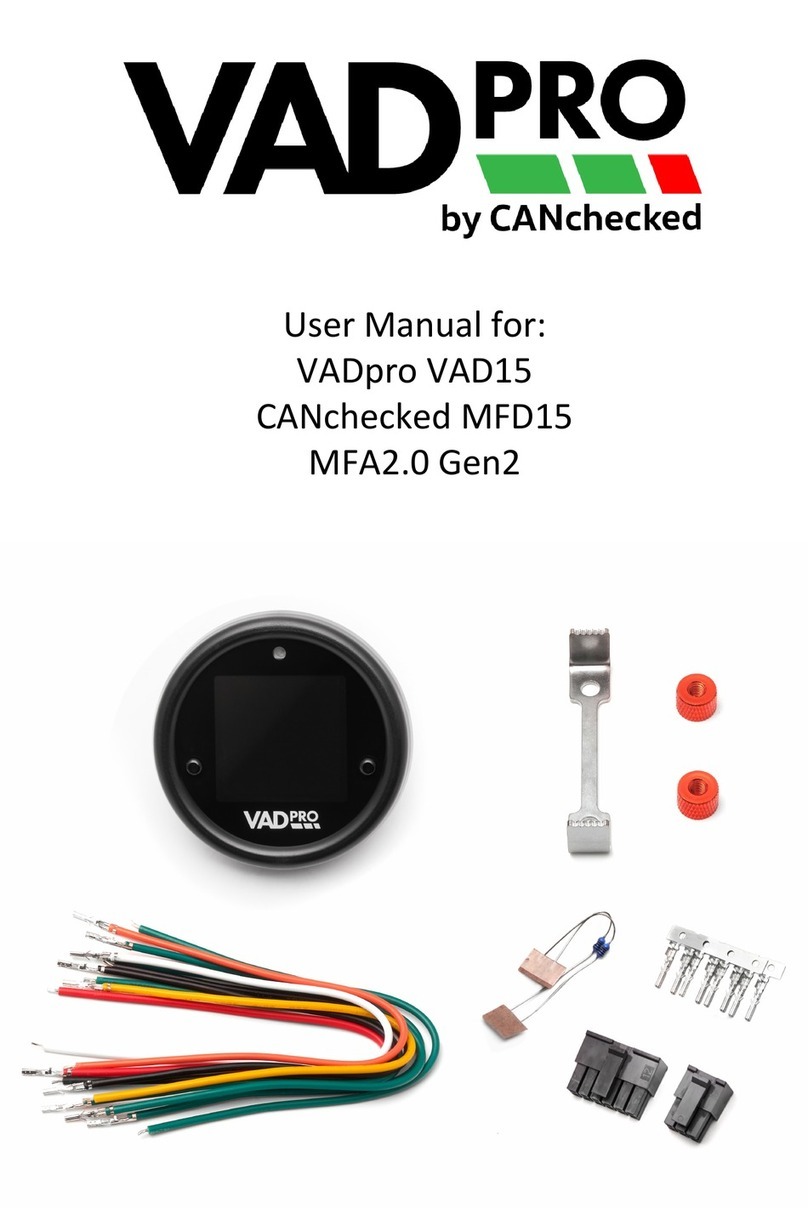
CANchecked
CANchecked VADpro VAD15 user manual
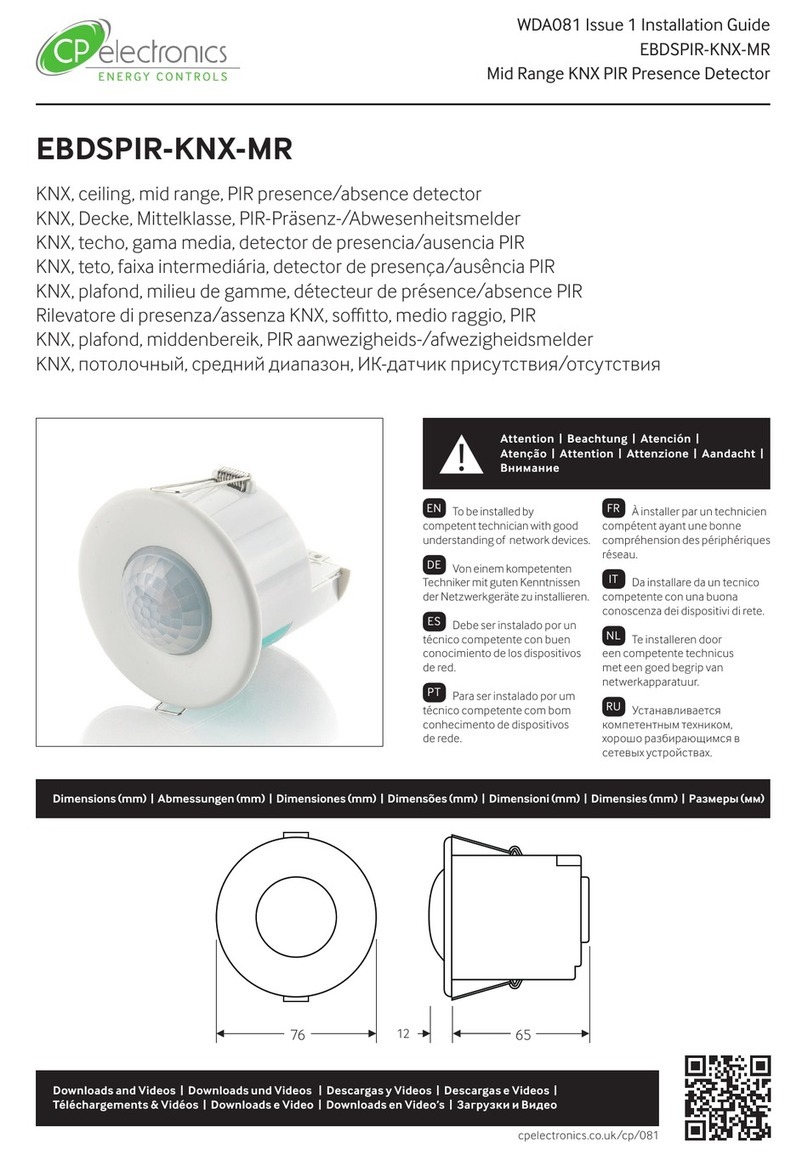
C.P. Electronics
C.P. Electronics EBDSPIR-KNX installation guide

Healthcraft
Healthcraft Tub-Rail TBR-S instruction manual
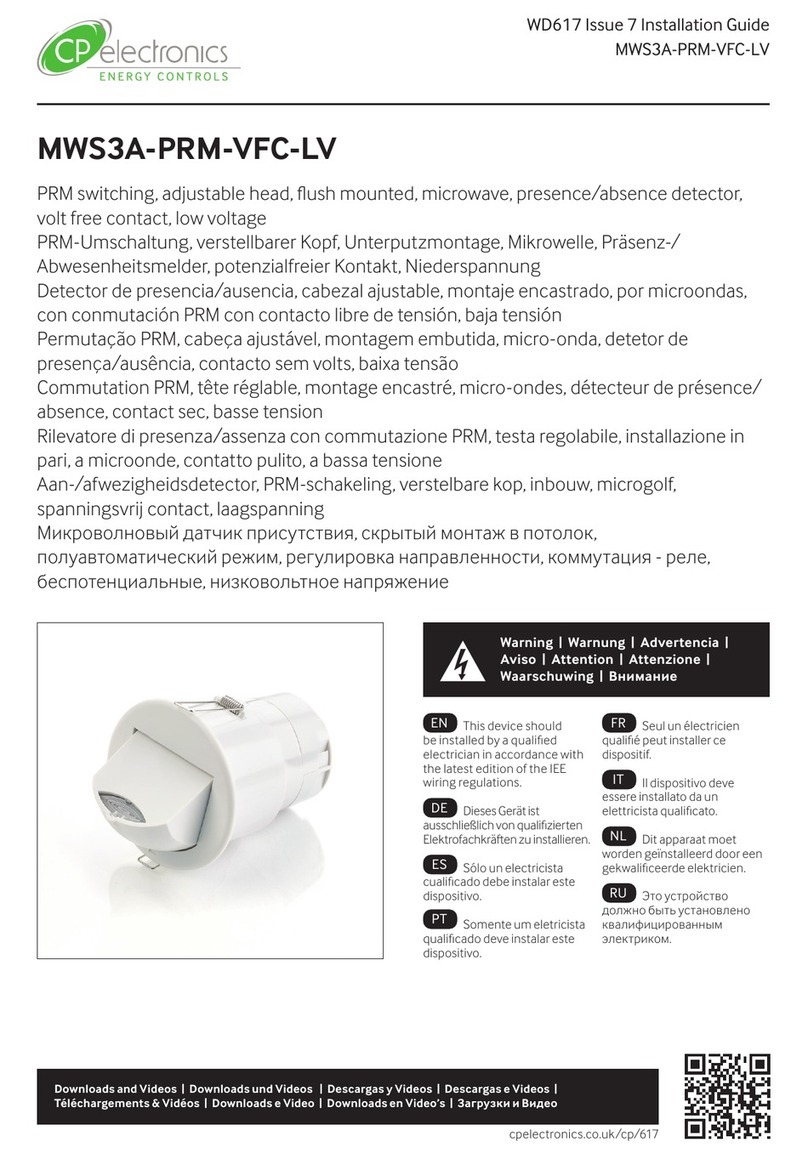
C.P. Electronics
C.P. Electronics MWS3A-PRM-VFC-LV installation guide
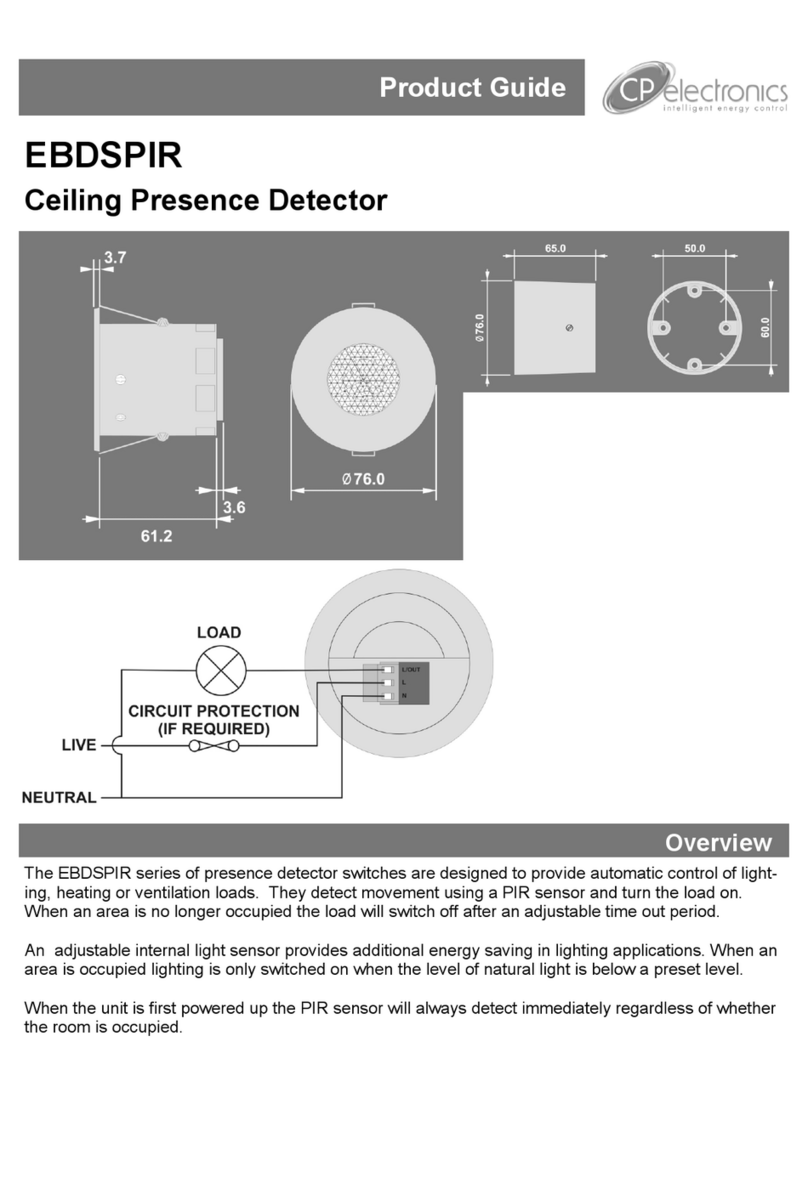
C.P. Electronics
C.P. Electronics EBDSPIR Product guide

Stec
Stec Duck-R instruction manual
